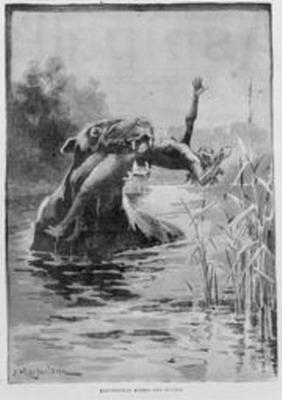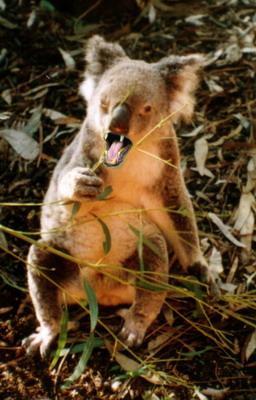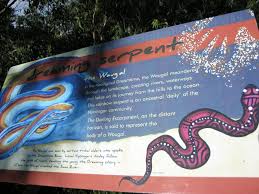|
Western Australia has a small number of mythical creatures that have popped up from time to time. The most famous of all is the Bunyip but there are others like the Yowie, Drop
bear and Hoop snake that are somewhat lesser known. Other mysteries exist outside the realm of mythical creatures. One that was brought to our attention is the falling stones
of Mayanup.
For other people's experiences you can check out Strange Encounters in Perth
Falling Stones of Mayanup
Mayanup as a place, is no more than a pin-prick on the map. It is located south of Boyup Brook on Blackwood Road. It would probably have remained
unknown and unremarkable except for a report in the Daily News in 1957 which (in part) read:
"Stones have been gently falling on the Keninup, Boyup Brook property of farmer W. W. M. Hack for nearly two years. The occurrences have been intermittent and generally at
the greatest intensity during the winter months."
The stones were apparently warm to the touch and seemed to materialise from nowhere. Reports say that some stones "fell slowly", others materialised inside buildings etc.
The events in question are said to have taken place over a number of years, 1946 - 1962 to be precise. Similar events have also been reported at Humphrey's Bridge (near
Wandering), as well as at Boddington and Borden.
The stones ranged from pebble sized all the way up to 19 kilograms. The news soon spread and people started travelling to the towns to see for themselves what was going on. Later
in 1957 the Daily News again reported:
"Just after the natives shifted camp the stone phenomenon was witnessed by dozens of independent white witnesses. At 5:30pm yesterday, when he returned from a nearby stock
sale, he found a crowd of people in a half-circle behind his house. Stones were falling. They were picking them up as fast as they fell."
Jack Coulter, Daily News 1957
In 2009 ABC TV aired a documentary about the 'Spirit Stones' that included interviews with people who had experienced the phenomenon. As fas as we know there has never been
a definitive explanation of just what the stones were and where they came from. (ABC TV page)
Some have blamed the stones on a ghost or poltergeist. Helen Hack wrote a book about it called 'The Mystery of the Mayanup Poltergeist'. We assume Helen Hack is related Douglas
Hack who was a witness to the falling stones. The National Library of Australia has a sound recording of an interview with Douglas Hack but as fas as we know it is not available online.
(Details at NLA Interview).
The Bunyip

The Bunyip seems to have developed from Aboriginal legends of a water monster that made a bellowing noise. Is is said to live in calm deep water that can be anything from a river to
a remote water hole.
The first reported sighting of a Bunyip by Europeans was in the early 1800s and one is said to have scared off a group of picnickers at Bold Park near Perth.
The Bunyip is described as having flippers, a horse like tail and tusks like a walrus. A strange skull found near the Murrumbidgee River in 1846 was thought to belong to a Bunyip.
It was even exhibited at the Australian Museum but recent searches have failed to locate the skull. At the time it was concluded that the skull was just a freak of some sort, but if it
could have been examined by modern scientific techniques it would have been more fully explained.
A hungry Bunyip is said to eat any animal that comes close to its waterhole but unless disturbed does not usually eat people.
The origins of the Bunyip may be a racial memory of the Aboriginal people that stems from something like a diprotodon that was becoming extinct as the earliest Aborigines began
arriving in Australia. The name it thought to be an Aboriginal word meaning devil or spirit.
In 1847 a report of a Bunyip sighting appeared in the Sydney Morning Herald:
"It was about as big as a six months' old calf, of a dark brown colour, a long neck, and long pointed head; it had large ears which pricked up when it perceived him (the herdsmen);
had a thick mane of hair from the head down the neck, and two large tusks. He turned to run away, and this creature equally alarmed ran off too, and from glance he took at it he
describes it as having an awkward shambling gallop; the forequarters of the animal were very large in proportion to the hindquarters, and it had a large tail."
A different type of Bunyip (the dog faced Bunyip) was reported many times between 1852 and 1932.The lack of reports in recent years seem to suggest that the Bunyip might now
be extinct, but next time you go down to the local waterhole for a swim keep an eye out - just in case.

Bunyip Skull
Drop Bear
(Phascolarctus Hodgsonii) also listed as (Thylarctos plummetus)

Probably the next most famous mythical creature in W.A. is the Drop Bear.
Described as a large muscular carnivorous koala with lage canine teeth, the tales of the Drop Bear have long been used to frighten gullible tourists sitting around a campfire
late at night in the remote outback.
The Drop Bear is said to leap down from trees on to its unwary prey sinking its huge fangs into the top of its' victim's skull.
It is often said that smearing vegemite or toothpaste behind the ears will put off any Drop Bear attacks.
Although difficult to determine the origins of this myth it has been suggested that it was first used to deter people (children especially) from sleeping under gum trees - as the
trees can drop heavy limbs without warning and are referred to as 'widow makers'.
At one time there were animals twice the size of the modern day koala living in trees. It is quite possible that an animal not unlike that described by this myth did in fact actually exist.
Stories of Drop Bears are usually delivered with a serious demeanour and overseas visitors may have difficulty establishing fact from fiction as most Australians are aware of the
Drop Bear joke and are more than ready to confirm its existence to visitors.

Drop Bear Warning Sign
In recent times it seems that the Drop Bear has developed a number of sub-species which include the Common, Burrowing, Alpine and even an Aquatic sub type with webbed feet and
hands, that drops on swimmers from trees overhanging peaceful waterways.
Just when you think you are sure the Drop Bear is just a myth, we include the following warning about Drop Bears that is quoted from the website : www.thetsf.org.au
'As you can imagine, admitting their existence would cause some degree of panic, and destroy parts of Australia's ecotourism industry overnight. It is for this reason that all government
departments will, and have denied any knowledge of the existence of the Drop Bear, and are likely to continue to do so in the future. Being an avid outdoor enthusiast, and having contact
with people who spend a large proportion of their time outdoors, I have gathered together scraps of information from sources all around the country, linking Drop Bear involvement to such
events as the disappearance of Azaria Chamberlain, the death of Captain James Cook in Hawaii, several war-time incidents in northern Australia, the disappearance of a group of
cross-country skiers in the Victorian Alps, and the deaths of a number of hikers, canoeists, 4WDrivers, campers, sunbathers and swimmers throughout the country. These 'accidents'
are often reported as crocodile attacks, falls from cliffs, exposure, and in the Chamberlain case, dingoes were blamed. I have it on good authority in all of these cases, however, that
a government cover-up was at work to dispel rumours of Drop Bear attacks and hide the truth from the public.'
Also see the Australian Museum - The Drop Bear
The Yowie
(Gigantopithecus australis)
Also called Yoser, Tjangara, Yowrie, Yayho, Koyoreowen, Lo-an, Jimbra, Turramulli, Jingera and Youree.

Although mostly associated with the Eastern States, the Yowie is worth mentioning here as they have been known to migrate and as the Western Australian outback is so vast there is
no telling when one may be encountered there.
The Yowie is possibly related to the American Bigfoot or Sasquatch and is very similar in appearance. A cousin of these creatures is the Yeti of South East Asia.
There are some Aboriginal dreamtime legends about battles with a race of hairy ape men with an emphatic victory going to the Aborigines because of their use of weapons whereas
the ape-men fought only with their bare hands.
All Yowie appear to be man or ape like but much taller than humans and covered with some sort of long hair or fur. Yowies are said to smell like the sparks given off by an electrical
appliance as it burns out so it is easy to tell if one is lurking about because the smell is so strong.
Hoop Snakes & Trip Snakes
(Oxyuranus Hulaii)

Hoop snakes have the unusual ability to grasp their own tails and by using rhythmic muscular contractions form themselves into a hoop shape and roll along at a much greater speed
than any normal snake can.
The Hoop Snake is not generally thought to be dangerous to people except for children who 'wag' school and spend their time riding bicycles through the bush. The snakes have a
strange desire to bite bicycle tyres and the heels of those riding the bike. Since the snakes are not fast enough to catch motorbikes, they are only a serious threat to pedal cycles.
A close relative of the Hoop Snake is the Trip Snake. Trip snakes are well camouflaged, looking much like an ordinary stick lying on the ground. They are often found near walking
trails through out the bush and are to be avoided at all costs.
Unlike the relatively harmless Hoop Snake, the Trip Snake is highly venomous and will first arch its back to trip a victim before sinking in its fangs and injecting a dose of paralysing
venom that quickly begins to liquefy tissue. If undisturbed, the trip snake can then drain the victim dry.
Min Min Lights

(C) Daniel Parsons from http://www.queenslandcountrylife.com.au
Min min lights are mysterious but are not creatures of any sort. They are usually seen out in remote areas late at night and can appear to follow as you move along.
There have been literally hundreds of sightings of min min lights over the years and no doubt exists as to their reality but what is mysterious is why these lights occur at all
and whey to they sometimes seem to respond to people's actions.
Experiments have revealed that the phenomenon is probably refracted light from some source that is not visible in the normal way.
"Professor Jack Pettigrew, of the University of Queensland in Brisbane claims the lights are actually an inverted mirage of light sources which are, in some cases, hundreds of
kilometres away over the horizon."
Is this the only explanation? It is perhaps somewhat more romantic to think of the lights as the spirits of lost bushwalkers and others who died in the outback. Not at all scientific
of course but somewhat more interesting.
Min min lights appear to operate in the same manner as landforms over the horizon that sometimes appear in inverted form floating in the air. This phenomenon is known as
Fata Morgana.
Thermal inversion layers in the air trap cold dense air next to the ground with warm thinner air above. This appears to refract light in such a way as to make it curve around the
surface of the Earth.
Wagyl

The Wagyl (pronounced woggle) is an Aboriginal dream-time creature that crawled through the landscape creating creeks and rivers.
The name is alternatively spelled, Waugl, Waugal or Waagal. It is also sometimes known as the rainbow serpent and is a totem on the
Noongar people of Western Australia.
The Noongar people were appointed guardians of the land by the Wagyl.
You might also like Dangerous Creatures
|















